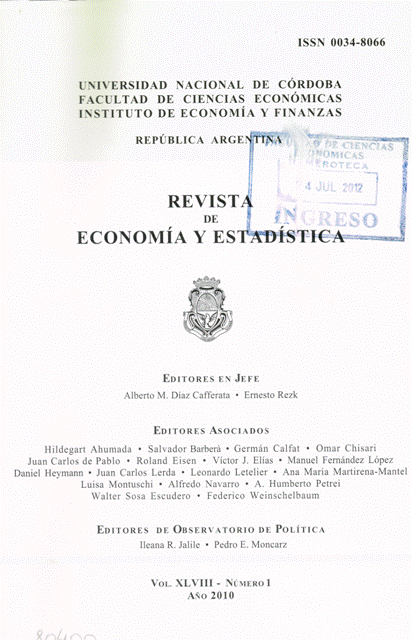La política fiscal en Estados Unidos: Estabilizadores automáticos, acciones de política fiscal discrecional y la economía
DOI:
https://doi.org/10.55444/2451.7321.2010.v48.n1.3870Palabras clave:
estabilizadores automáticos, presupuesto , políticas discrecionalesResumen
Examinamos los efectos de los ciclos de la economía en el presupuesto del gobierno como así también los efectos del presupuesto del gobierno en los ciclos de la economía. Primero, proveemos medidas de los efectos de los estabilizadores automáticos sobre los presupuestos federales, estatales y locales. Para el gobierno federal, el déficit se incrementa alrededor de un 0,35 por ciento del PIB por cada desviación de 1 punto porcentual del PIB real con respecto al PIB potencial. Para los gobiernos estatales y locales, el déficit aumenta en un 0,1 por ciento del PIB. Luego se examina la respuesta de la economía a los estabilizadores automáticos utilizando el modelo FRB/US comparando la respuesta a shocks de demanda agregada en dos escenarios: con estabilizadores automáticos y sin estabilizadores automáticos. En segundo lugar, proporcionamos medidas de las acciones discrecionales de política fiscal a nivel federal, estatal y local. Encontramos que las políticas federales son de alguna manera contra-cíclicas, mientras que las políticas estatales y locales han sido un tanto pro-cíclicas. Por último, se evalúa el impacto del presupuesto, tanto de los estabilizadores automáticos como de las medidas discrecionales, en la actividad económica en 2008 y 2009.
Descargas
Referencias
Autor and Duggan (2006). “The Rise in Disability Rolls and the Decline in Unemployment,” Journal of Economic Perspectives, Summer 71-96.
Auerbach, Alan J. (2003). “Fiscal Policy, Past and Present,” Brookings Papers on Economic Activity, 1, pp. 75-122.
Aizeman, Joshua and Gurnain Kaur Pasricha (2010). “On the Ease of Overstating the Fiscal Stimulus in the US, 2008-9,” NBER working paper 15784.
Blank, Rebecca (2001). “What Causes Public Assistance Caseloads to Grow?” Journal of Human Resources 36 No. 1 (Winter): 85-118.
Bryaton, F. and P. Tinsley (eds.) (1996). “A Guide to FRB/US: A Macroeconomic Model of the United States” Finance and Economics Discussion Series 1996-42. Washington: Board of Governors of the Federal Reserve System.
Cohen, Darrel (1987). “Models and Measures of Fiscal Policy.” Working Paper Series, Economic Activity Section, No. 70. Washington D.C.: Board of Governors of the Federal Reserve System.
Cohen, Darrel and Jason Cummins (2006). “A Retrospective Evaluation of the Effects of Temporary Partial Expensing,” Finance and Economics Discussion Series, 2006-19.
Cohen, Darrel and Glenn Follette (2000). “The Automatic Fiscal Stabilizers: Quietly Doing Their Thing.” Economic Policy Review 6 No. 1 (April): 35-68.
Coronado, Julia, Joseph Lupton and Louise Sheiner (2005). “The Household Spendng Response to the 2003 Tax Cut: Evidence from Survey Data,” Finance and Economics Discussion Series, 2005-32.
Council of Economic Advisers (2010). “The Economic Impact of the American Recovery and Reinvestment Act of 2009 Second Quarterly Report,” January 13.
deLeeuw, Frank, Thomas Holloway, Darwin Johnson, David McClain, and Charles Waite (1980). “The High-Employment Budget: New Estimates, 1955-1980.” Survey of Current Business (November): 13-43.
Follette, Glenn, Andrea Kusko and Byron Lutz (2008). “State and Local Finances and the Macroeconomy: The High-employment Budget and Fiscal Impetus,” National Tax Journal, September.
House, Christopher, and Matthew Shapiro (2008). “Temporary Investment Tax Incentives: Theory with Evidence from Bonus Depreciation,” American Economic Review, September, 1028-1038.
Johnson, David, Jonathan Parker and Nicholas Souleles (2004). “Household Expenditure and the Income Tax Rebates of 2001,” NBER working paper 10784.
Kalman, Rupp, and David Stapleton (1995). “Determinant of the Growth in the Social Security Administration’s Disability Programs—An Overview,” Social Security Bulletin, Winter.
Knight, Brian (2002). “Endogenous Federal Grants and Crowd-out of State Government Spending: Theory and Evidence from the Federal Highway Aid Program,'' American Economic Review, 92(1).
Knight, Brian, Andrea Kusko and Laura Rubin (2003). “Problems and Prospects for State and Local Governments.” State Tax Notes (August 11): 427-439.
Sahm, Claudia R., Mathew D. Shapiro, and Joel Slemrod (2009). "Household Response to the 2008 Tax Rebates: Survey Evidence and Aggregate Implications," Prepared for the NBER Conference on Tax Policy and the Economy Washington, DC (September).
Lutz, Byron (2008). “The Connection Between House Price Appreciation and Property Tax Revenues.” National Tax Journal (September).
Lutz (2010). "Taxation with Representation: Intergovernmental Grants in A Plebiscite Democracy", Review of Economics and Statistics, forthcoming.
National Association of State Budget Officers (2009). The Fiscal Survey of the States. Washington, D.C. (June).
National Conference of State Legislatures (2008). State Budget Actions FY 2007 and FY 2008. Denver CO. April.
U.S. Congressional Budget Office (2010). “Estimated Impact of the American Recovery and Reinvestment Act on Employment and Economic Output From October 2009 Through December 2009,” February.
U.S. Congressional Budget Office (various years). The Budget and Economic Outlook. Washington D.C.
van den Noord, Paul (2000). “The Size and Role of Automatic Fiscal Stabilizers in the 1990s and Beyond”, OECD Economics Department Working Papers, No. 230.
Descargas
Publicado
Número
Sección
Licencia
Derechos de autor 2010 Glenn Follette, Byron Lutz

Esta obra está bajo una licencia internacional Creative Commons Atribución-NoComercial-SinDerivadas 4.0.
Aquellos autores/as que tengan publicaciones con esta revista, aceptan los términos siguientes:
Los autores/as conservarán sus derechos de autor y garantizarán a la revista el derecho de primera publicación de su obra, el cuál estará simultáneamente sujeto a la Licencia Creative Commons Atribución-NoComercial-SinDerivar 4.0 Internacional que permite a terceros compartir la obra siempre que se indique su autor y su primera publicación esta revista.
Los autores/as podrán adoptar otros acuerdos de licencia no exclusiva de distribución de la versión de la obra publicada (p. ej.: depositarla en un archivo telemático institucional o publicarla en un volumen monográfico) siempre que se indique la publicación inicial en esta revista.
Se permite y recomienda a los autores/as difundir su obra a través de Internet (p. ej.: en archivos telemáticos institucionales o en su página web) antes y durante el proceso de envío, lo cual puede producir intercambios interesantes y aumentar las citas de la obra publicada. (Véase El efecto del acceso abierto)














